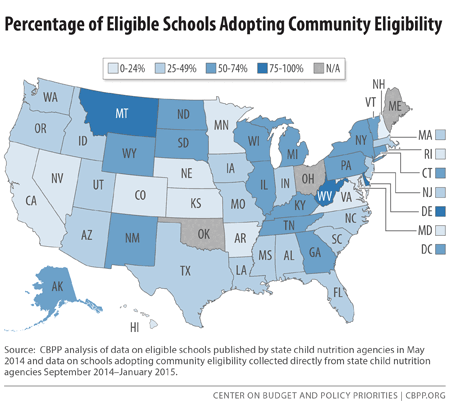off the charts
POLICY INSIGHT
BEYOND THE NUMBERS
BEYOND THE NUMBERS
Could Your School District Streamline Its Breakfast and Lunch Programs?
Receive the latest news and reports from the Center
Community eligibility supports Congress’ longstanding goal of reducing paperwork for high-poverty schools by enabling them to offer breakfast and lunch at no charge to all students without collecting and processing individual meal applications. In its first year of nationwide implementation, more than 14,000 high-poverty schools serving more than 6.6 million children have adopted the option. Our new report and searchable database help parent organizations, teachers, and other stakeholders in low-income communities identify which school districts have adopted community eligibility and which others could benefit from it in the next school year.
We’ve measured the share of eligible school districts that implemented community eligibility in at least one school, the share of eligible schools that adopted it, and the share of the highest-poverty schools (where community eligibility is most feasible financially for districts because their federal meal reimbursements are the largest) that adopted it.
Although community eligibility was widely implemented this year, participation among eligible schools varied widely by state (see map). Many more high-poverty schools could benefit from streamlining their meal programs and freeing up resources for educational priorities. More importantly, millions more low-income children would be better able to learn if they received breakfast and lunch without hassle or stigma. This spring, school districts will have another opportunity to examine if community eligibility could benefit their schools and students.
